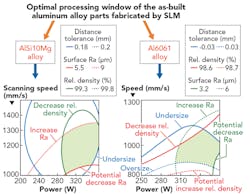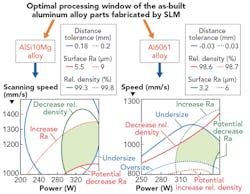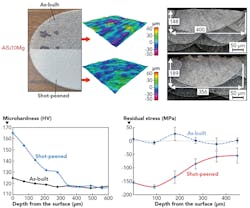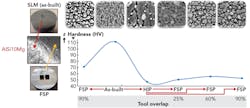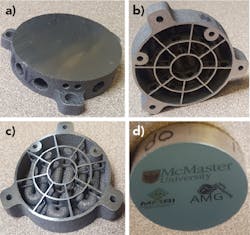Optimized additive manufacturing for lightweight metallic components
Recycled aluminum powder enables a cost-effective process
AHMED MAAMOUN
The upcoming industrial revolution known as Industry 4.0 promises a new age of advanced manufacturing. Industry 4.0 is powered by the current development in some fields, such as additive manufacturing (also known as 3D printing), autonomous robots, predictive maintenance and analytics, software integration, and cybersecurity. Additive manufacturing of metals offers a variety of solutions to reduce current design and manufacturing limitations, and therefore will improve part performance and customization.
Selective laser melting (SLM) is the commonly used technique for the additive manufacturing of metals, using a laser beam to melt each powder layer according to the slices generated from the 3D CAD model. The technique can provide near-net shape objects compared to subtractive manufacturing (CNC machining), and thus will have a significant impact on workpiece development.
SLM can also be used to produce efficient tools for forming and die casting technologies.
Additive manufacturing of aluminum alloys promises a production of efficient, flexibly designed, and lightweight parts using the SLM technique. However, some challenges to widen SLM applications, such as obtaining consistent material properties, improving the quality of fabricated parts, and reducing their production cost, are an active research issue.
Recently, some significant contributions to improve the quality and reduce the production cost of parts produced using SLM were achieved by the author during his Ph.D. research. The work focused on optimizing the quality and cost of additively manufactured aluminum parts applied in some critical applications specifically for the metal mirrors of high-power laser system or wide-view space telescopes.
The primary goals of this research focused on reducing or eliminating the defects derived from the as-built parts such as microstructure inhomogeneity, porosity, and surface defects. These targets were achieved through five comprehensive studies followed by a case study of a typical TMA telescope mirror.
Cost-effective recycled powder
A full characterization of both fresh and recycled aluminum alloy (AlSi10Mg) powder, according to ASTM F3049-14, shows the possibility of reusing it to be part of a cost-effective additive manufacturing process using the SLM technique.1
The recycled powder was reused for 18 previous builds after providing proper recycling procedures. The powder characterization results showed similar properties between both fresh and recycled powders, and there was no loss in the quality of parts fabricated using the recycled powder. It is worthwhile to note that the size of the sputtering particles of this aluminum alloy exceeds 100 µm, and thus helps to exclude these particles after sieving with a mesh size of 75 µm. This work has a significant impact on the production cost reduction of each build process by hundreds of dollars.
Customization of the product quality
A comprehensive study regarding the effect of SLM process parameters on the quality of parts was presented.2, 3 A process map was established to optimize the performance characteristics of the as-built aluminum parts fabricated (FIGURE 1).
FIGURE 1. The effect of the SLM process parameters on the quality of as-built AlSi10Mg parts is shown.
The process map was developed for Al6061 and AlSi10Mg alloys according to the design of experiments (DOE) analysis using a full factorial technique. The developed map investigates the behavior of relative density, surface roughness, and dimensional accuracy along the selected range of the SLM process parameters, in addition to characterizing the parts’ microstructure and mechanical properties.
It was found that AlSi10Mg is a more compatible aluminum alloy to be used for the SLM process than Al6061 alloy because of the relatively lower coefficient of thermal expansion of AlSi10Mg, which prevents crack formation and part contraction after solidification. The optimum relative density of 99.7% of parts is achieved using energy density of 50 J/mm3 through a laser power of
370 W, a scan speed of 1300 mm/s, and a 30 µm layer thickness.
Since some critical components, such as those used in aerospace applications, need higher quality than that obtained from the as-built parts, it is necessary to apply post-processing treatment to satisfy the design requirements of these components.
Thermal post-processing of parts fabricated using recycled powder
FIGURE 2 illustrates the developed microhardness map after thermal post-processing of the as-built parts using recycled AlSi10Mg powder. The influence of thermal post-processing was studied under different conditions, including annealing, solution heat treatment (SHT), and T6 heat treatment (T6 HT). The results showed a significant improvement in the microstructure homogeneity under specific conditions with a variety of selection for the desired mechanical properties. The developed map assists in the selection of optimized thermal post-processing parameters, which could satisfy the design requirements.1
FIGURE 2. A microhardness map for thermal post-processing of AlSi10Mg samples shows a cross-section fabricated by SLM.
Shot peening improvement
Shot peening was also applied to the as-built part as a cold working process that bombards the part surface with spherical beads using high pressure. Shot peening of the as-built AlSi10Mg surfaces resulted in the elimination of the surface defects, microstructure refinement, surface hardening, and the application of high compressive stress into a specific depth from the sample surface (FIGURE 3).4 The increase of surface microhardness is extended along a specific depth from the sample surface up to 500 µm. The compressive residual stress generated along the peened area could lead to an improvement of the mechanical properties and fatigue strength of the sample surface.
FIGURE 3. The influence of shot peening on AlSi10Mg parts fabricated by additive manufacturing is shown.
Friction stir processing for deep localized surface treatment
Friction stir processing (FSP) is considered to be an intense plastic deformation process that could change the material properties. The method was studied as a localized treatment on a large surface area of the as-built and hot isostatic pressed (HIPed) AlSi10Mg parts using multiple FSP tool passes. The influence of FSP on the microstructure, hardness, and residual stresses of parts was investigated.5 FSP transforms the microstructure of parts into an equiaxed grain structure. A consistent microstructure homogenization was achieved over the processed surface after applying a high ratio of tool pass overlap of ≥60%. FIGURE 4 shows a map of microstructure and hardness that was prepared to assist in the selection of the optimal FSP parameters for attaining the required quality of the final processed parts.
FIGURE 4. Friction stir processing of AlSi10Mg parts produced by SLM is shown.
It is worthwhile to note that the process maps developed in the studies could help to customize the fabricated part characteristics according to the desired quality to achieve its design requirements. The ongoing efforts in the R&D sector of the additive manufacturing field promise more considerable achievements to overcome the as-built defects completely. After that, additive manufacturing could supply a qualified part that satisfies both design and quality requirements.
Additive manufacturing reduces part weight, improves its performance
A novel mirror structure is developed using the design for additive manufacturing (DFAM) concept. This design achieved a weight reduction of 50% as compared to the typical mirror structure.6 Moreover, the developed design offers an improvement of the mirror cooling performance due to the embedded cooling channels in the mirror surface (FIGURE 5). The ultraprecision machined surface of the additively manufactured AlSi10Mg part showed a surface roughness that reached 2 nm using the single-point diamond turning (SPDT) technique.
FIGURE 5. The results of an optical metallic mirror case study show a typical design (a), developed design (b, c), and machined mirror surface (d).
In general, additive manufacturing will offer a cost-effective production process of an efficient, customized, and high-quality product. The smart factory 4.0 will provide many solutions for existing production limitations using additive manufacturing and automation systems. Current achievements undoubtedly will lead to an increase in the productivity and the growth of various applications in different fields, such as aerospace, automotive, biomedical, military, and beyond.
The new age of advanced manufacturing will start once the underlying technology issues have been solved. At this time, conventional design and production strategies will be changed towards more flexible, productive, and smarter production systems. ✺
ACKNOWLEDGEMENT
The author would like to acknowledge Dr. Mo Elbestawi, Dr. Stephen Veldhuis, Dr. Julia Dosbaeva, and Mr. Jack Xue for their contribution in the current work achievements.
REFERENCES
1. A. H. Maamoun, M. Elbestawi, G. K. Dosbaeva, and S. C. Veldhuis, Addit. Manuf., 21, 234–247 (2018); https://doi.org/10.1016/j.addma.2018.03.014.
2. A. H. Maamoun, Y. F. Xue, M. A. Elbestawi, and S. C. Veldhuis, Materials, 11, 2343 (2018); https://doi.org/10.3390/ma11122343.
3. A. H. Maamoun, Y. F. Xue, M. A. Elbestawi, and S. C. Veldhuis, Materials, 12, 12 (2019); https://doi.org/10.3390/ma12010012.
4. A. Maamoun, M. Elbestawi, and S. Veldhuis, J. Manuf. Mater. Process., 2, 40 (2018); https://doi.org/10.3390/jmmp2030040.
5. A. H. Maamoun, S. C. Veldhuis, and M. Elbestawi, J. Mater. Process. Technol., 263, 308–320 (2019); https://doi.org/10.1016/j.jmatprotec.2018.08.030.
6. A. H. Maamoun, “Selective laser melting and post-processing for lightweight metallic optical components,” Ph.D. Thesis, McMaster University (Jan. 2019); www.researchgate.net/profile/ahmed_maamoun5.
Dr. AHMED MAAMOUN([email protected]) is a research assistant in the Additive Manufacturing Group (AMG) and the McMaster Manufacturing Research Institute at McMaster University, Hamilton, ON, Canada; www.eng.mcmaster.ca/mcmaster-manufacturing-research-institute-mmri.
